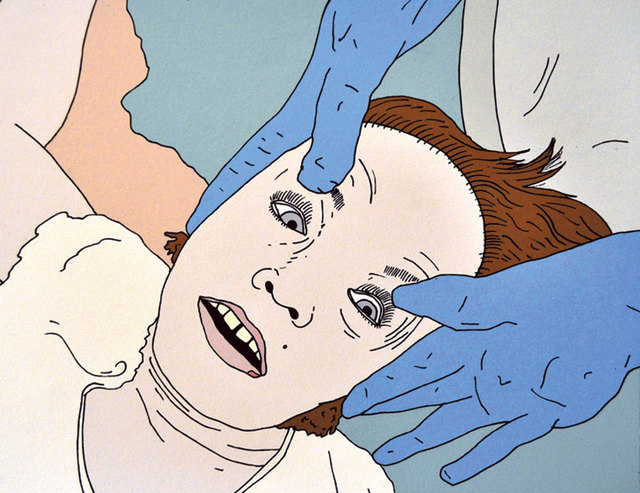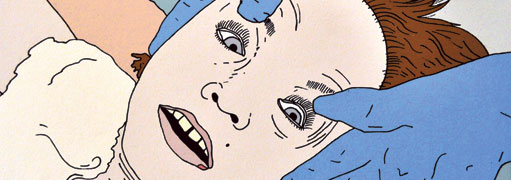There’s that joke: What do you get when you play country music backward? You get your house, your truck and your wife back. At its heart, it’s a joke about how depressing country music can be. Nobody wants to hear about the realities of divorce, alcoholism or depression through their radios. Artists have often used life’s lows as rich fodder for their visual material, and the current drawing show at The Normal Gallery is a good example of that.Named after the Townes Van Zandt song “High, Low and in Between,” the show features figurative work by Bart Johnson, Mike Paré, Larry Bob Phillips and Tamara Zibners. The song is a good backdrop for a show that props up the figure as a fantasy role player (Johnson) or simply as an object to pose in musings about death (Zibners).Johnson is the love child that Mercer Mayer and Hieronymus Bosch would have hoped for. The children’s book author and the Netherlandish painter would certainly be proud of Johnson’s ability to make scenes that simultaneously attract and repulse, filled with characters that just border on real. The works are sad and funny, their tableaux filled with animal heads, people, masks, rats and animal-helicopter hybrids. In one of the first pieces in the show, men greet each other on the street while giant figures twist and turn in the sky, falling toward the earth in the background. Johnson sets the tone for the rest of High, Low and in Between , his work balancing high craft, humor and anxiety at every turn. The three works by Larry Bob Phillips are all scenes of Eden. In one, an old couple holds a baby. In another, a younger couple having sex below a waterfall stops long enough to notice a bird flying overhead. Is it an omen? The final landscape has the couple lounging under a tree. Phillips’ calligraphic marks hold and hide, the entirety of each page crowded with nothing and everything. It’s a visual trip filled with really good punch lines, though I couldn’t escape the nagging feeling that the work hinged on a certain fear of death, but maybe that’s what I brought to the table. One of the real strengths of Phillips’ work is that you feel like it’s always existed.To be blunt: Tamara Zibners’ work flattens you. Her 11 digital prints float in a tertiary madness where heads are blown off, eyes are pried open and bodies lay cut in half. The kicker is her use of color (the tertiary from above), where vermillion meets chartreuse or baby blue or brown. Where Phillips hints at the arc of life, Zibners sticks her fingers in the corpse, wiggling them around, looking for diamonds or loose change. It’s the little details that pull you in—the bolts on the train tracks, the autumn leaves, the tattoos. She includes enough information so that the narrative can be accurately maligned. For example, in “Asthma” we see two hands, one clutching an inhaler, set between the leg of a table and the leg of our bronchospastic victim. It’s an aerial scene set against a green floor. The color looks like it was selected directly from this year’s Pottery Barn collection; which makes it all the more eerie, because Zibners is giving you permission to match it with your couch.Mike Paré has two large graphite drawings in the show. One shows a Merlin-like figure looking for a book on a shelf. The other shows a shirtless guy watering with a hose. Both drawings feature singular figures, with a focus on those figures’ singular activities—looking for a book, watering a garden. The men in Paré’s work seem numbed, embracing a dispassionate stance for anything beyond their small movements. I don’t think he was trying to draw boredom, but it’s like Paré willed into existence the visual equivalent of a rut. That said, the movement of Paré’s marks carries you through the drawing—especially in “Devotee in the Garden.” You also spend a lot of time trying to figure out how they were made—you look at what could be transfers, rubbings, projected or free-hand drawings.Formally, High, Low and in Between is a scattershot exhortation on the value of exploring the figure in drawing. Deeper than that, though, the four artists in this show hold up little mirrors not only to how we look at the world but also to how we see ourselves in it. And all of these mirrors are effectively drawn from lives lived and examined, because the human figure in art reveals the plight of a creature we’re all sympathetic to: ourselves.
High, Low and in Between: Figurative Works on Paper The Normal Gallery1415 Fourth Street SWRuns through Dec. 31Gallery hours are subject to change: Call Eli Wentzel-Fisher at (515) 520-7286.











